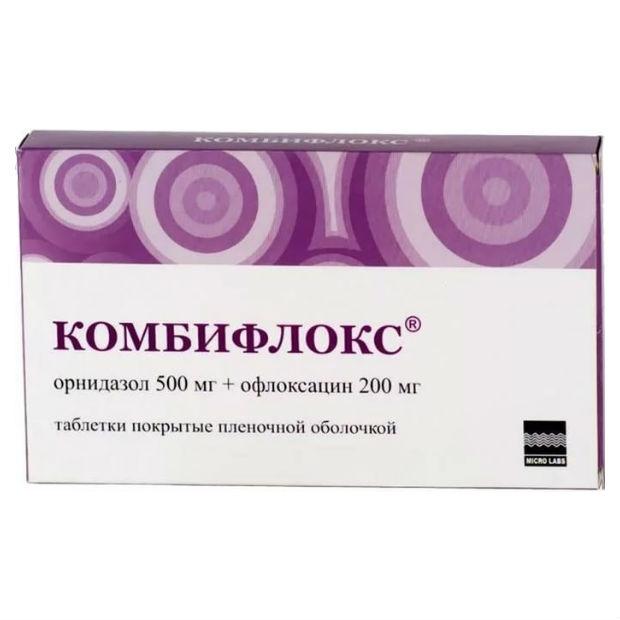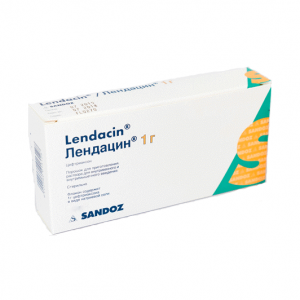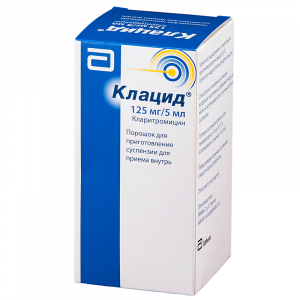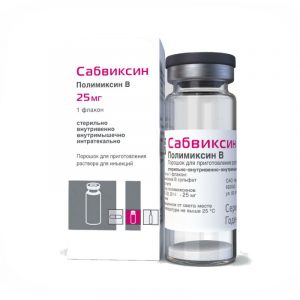Description
release form
film-coated tablets
packaging 20 pcs
Pharmacological action
Combiflox – a combined drug whose action is due to the components that make up its composition.
Ornidazole is an antiprotozoal and antimicrobial agent derived from 5-nitroimidazole. The mechanism of action is the biochemical reduction of the 5-nitro group of ornidazole by intracellular transport proteins of anaerobic bacteria and protozoa. The reduced 5-nitro group of ornidazole interacts with the DNA of microorganism cells, inhibiting the synthesis of their nucleic acids, which leads to the death of bacteria.
Active against Trichomonas vaginalis, Giardia lamblia, Entamoeba histolytica, as well as anaerobes Bacteroides spp. (including Bacteroides fragilis, Bacteroides distasonis, Bacteroides ovatus, Bacteroides thetaiotaomicron, Bacteroides vulgatus), Fusobacterium spp., Clostridium spp. Aerobic microorganisms are not sensitive to ornidazole.
Ofloxacin – a broad-spectrum antimicrobial agent from the group of fluoroquinolones, acts on the bacterial enzyme DNA gyrase, which provides supercoiling, etc. stability of bacterial DNA (destabilization of DNA chains leads to their death). It has a bactericidal effect.
The antimicrobial spectrum includes gram-positive aerobes: Staphylococcus aureus (methicillin-sensitive), Staphylococcus epidermidis (methicillin-sensitive), Staphylococcus saprophyticus, Streptococcus pneumoniae (penicillin-sensitive), Streptococcus.
Gram-negative aerobes: Acinetobacter calcoaceticus, Bordetella pertussis, Citrobacter freundii, Citrobacter koseri, Enterobacter aerogenes, Enterobacter cloacae, Escherichia coli, Haemophilus ducreyi, Haemophilus influenzae, Klebsiella oxytoca, Moraxella catarrhalis, Morganella morganii, Klebsiella pneumoniae, Neisseria gonorrhoeae, Proteus mirabilis, Proteus vulgaris, Providencia rettgeri, Providencia stuartii, Pseudomonas aeruginosa (quickly develop resistance), Serratia marcescens.
Anaerobes: Clostridium perfringens.
Others: Chlamydia trachomatis, Chlamydia pneumoniae, Gardnerella vaginalis, Legionella pneumophila, Mycoplasma hominis, Mycoplasma pneumoniae, Ureaplasma urealyticum.
In most cases, insensitive: Nocardia asteroides, anaerobic bacteria (including Bacteroides spp., Peptococcus spp., Peptostreptococcus spp., Eubacterium spp., Fusobacterium spp., Clostridium difficile), Enterococcus spp., Most Streptococcus spp., Does not affect Treponema pallidum.
Indications
mixed bacterial infections caused by sensitive gram-positive and gram-negative microorganisms in association with anaerobic microorganisms and / or protozoa
infectious and inflammatory diseases of the abdominal cavity and biliary tract, kidneys (pyelonephritis), urinary tract (pyelonephritis), lower urine (pyelonephritis), genitals and pelvic organs (endometritis, salpingitis, oophoritis, cervicitis, parametritis, prostatitis, colpitis, orchitis, epididymitis).
Contraindications
epilepsy (including a history)
decrease in the seizure threshold (including after a head injury, stroke or inflammation in the central nervous system
tendon damage with previous treatment with sperlcholine pregnancy
lactation period
hypersensitivity to ofloxacin, ornidazole, other fluoroquinolones and imidazole derivatives, components of the drug
Precautions: cerebral arteriosclerosis, cerebrovascular accident (history), chron Ceska renal failure, liver disease, liver failure, organic CNS diseases (including multiple sclerosis), a predisposition to convulsive reactions, myasthenia, hepatic porphyria, deficiency of glucose-6-phosphate dehydrogenase, diabetes, congenital prolongation of the QT interval syndrome, heart disease (heart failure, myocardial infarction, bradycardia), psychoses and other mental disorders in the history of simultaneous administration of drugs that extend the QT interval (antiarrhythmic IA and III classes, tricyclic and tetracyclic antidepressants, antipsychotics, macrolides, antigens , some antihistamines, including astemizole, terfenadine, ebastin), agents for general anesthesia from the group of barbiturates, drugs that reduce blood pressure, electrolyte imbalance ans (for example, with hypokalemia, hypomagnesemia), advanced age, alcoholism.
Use during pregnancy and lactation
Use of the drug during pregnancy and lactation is contraindicated. If necessary, use the drug during lactation should stop breastfeeding.
Composition
1 tablet contains ornidazole 500 mg, ofloxacin 200 mg
Dosage and administration
Combiflox is taken orally, 1 hour before meals or 2 hours after meals, with plenty of water. Do not break, chew, or break the tablet.
Recommended dose – 1 tablet 2 times a day for 7-10 days.
Dosing regimen for chronic renal failure (ofloxacin dose calculation): with KK 50-20 ml / min – 200 mg once every 24 hours, with KK less than 20 ml / min, with hemodialysis, peritoneal dialysis – 200 mg 1 time every 48 hours .
In liver failure, the maximum daily dose is 2 tablets (400 mg ofloxacin).
Side effects of the
Digestive system: gastralgia, loss of appetite, nausea, vomiting, diarrhea, constipation, flatulence, abdominal pain, increased activity of hepatic transaminases, hyperbilirubinemia, cholestatic jaundice, pseudomembranous mucous colitis, dryness, including hemorrhagic), hepatitis.
From the side of the nervous system: headache, dizziness, insomnia, nervousness, insecurity of movements, tremors, cramps, numbness and paresthesias of the limbs, intense dreams, nightmares, anxiety, agitation, phobias, depression, confusion, hallucinations, increased intracranial pressure insomnia nervousness, drowsiness, epileptic seizures, extrapyramidal disorders, psychotic reactions with a tendency to suicide, sensory or sensory motor peripheral neuropathy, impaired coordination of movement, temporary loss of consciousness.
From the musculoskeletal system: tendonitis, myalgia, arthralgia, tendosynovitis, tendon rupture, pain in the extremities, muscle stiffness, rhabdomyolysis, muscle weakness.
On the part of the sensory organs: impaired color perception, diplopia, impaired taste, perversion of taste, impaired smell, hearing and balance.
From the cardiovascular system: tachycardia, increase or decrease in blood pressure, collapse, lengthening of the QT interval, ventricular arrhythmia, including ventricular arrhythmia tachysystolic type pirouette.
Allergic reactions: skin rash, itching, urticaria, allergic pneumonitis, allergic nephritis, eosinophilia, fever, angioedema, bronchospasm multiforme exudative erythema (including Stevens-Johnson syndrome) and toxic epidermal necrolysis (Lyell’s syndrome), photosensitivity, vasculitis, women anaphylactic shock .
From the skin: spot hemorrhages (petechiae), bullous hemorrhagic dermatitis, papular rash with a crust, indicating vascular damage (vasculitis).
From the hemopoietic organs: leukopenia, agranulocytosis, anemia (including aplastic and hemolytic), thrombocytopenia, pancytopenia.
From the urinary system: acute interstitial nephritis, impaired renal function, hypercreatininemia, increased urea concentration, dysuria, urinary retention, acute renal failure.
Other: intestinal dysbiosis, superinfection, hypoglycemia (in patients with diabetes mellitus), vaginitis, chest pain, fatigue, asthenia, general weakness, photosensitivity, vaginal discharge, nosebleeds, thirst, weight loss, pharyngitis, rhinitis, dry cough acute attack of porphyria (in patients with porphyria).
Drug Interaction
Ofloxacin: Reduces theophylline clearance by 25% (co-administration of theophylline dose).
Increases the concentration of glibenclamide in plasma. Increases the serum concentration of cyclosporine.
Cimetidine, furosemide, methotrexate and drugs (blocking drugs) that block tubular secretion increase the concentration of ofloxacin in blood plasma. When co-administered with indirect anticoagulants (coumarin derivatives, including warfarin), coagulation of the blood should be monitored. When administered with non-steroidal anti-inflammatory drugs, nitroimidazole derivatives and methylxanthines, the risk of developing neurotoxic effects, including seizures, is increased.
Concurrent administration with glucocorticosteroids increases the risk of tendon rupture, especially in the elderly.
When administered with urinary alkaline drugs (carbonic anhydrase inhibitors, citrates, sodium bicarbonate), the risk of crystalluria and nephrotoxic effects is increased. When administered with hypoglycemic agents, both hypoglycemia and hyperglycemia are possible, in this connection it is necessary to control the plasma glucose concentration.
When used with drugs that prolong the QT interval, antiarrhythmic IA and III classes, tricyclic and tetracyclic antidepressants, neuroleptics, macrolides, antifungal, some antihistamines, incl. astemizole, terfenadine, ebastine) QT interval may be prolonged. Foods, antacids containing ions of aluminum, calcium, magnesium, or iron salts reduce the absorption of ofloxacin, forming insoluble complexes (the time interval between the administration of these drugs must be at least 2 h).
Ornidazole: Enhances the effect of indirect coumarin anticoagulants, prolongs the muscle relaxant action of vecuronium bromide.
Compatible with ethanol (does not inhibit acetaldehyde dehydrogenase) unlike other imidazole derivatives (metronidazole).
Overdose
Symptoms: dizziness, confusion, drowsiness, disorientation, drowsiness, vomiting, epileptiform convulsions, depression, peripheral neuritis.
Treatment: gastric lavage, symptomatic therapy (diazepam – in convulsions).
Storage conditions
In the dark place at a temperature of no higher than 25 ° C.
The Expiration of
is 3 years.
Terms of delivery from
pharmacies Prescription
dosage form
Formulation
tablets




